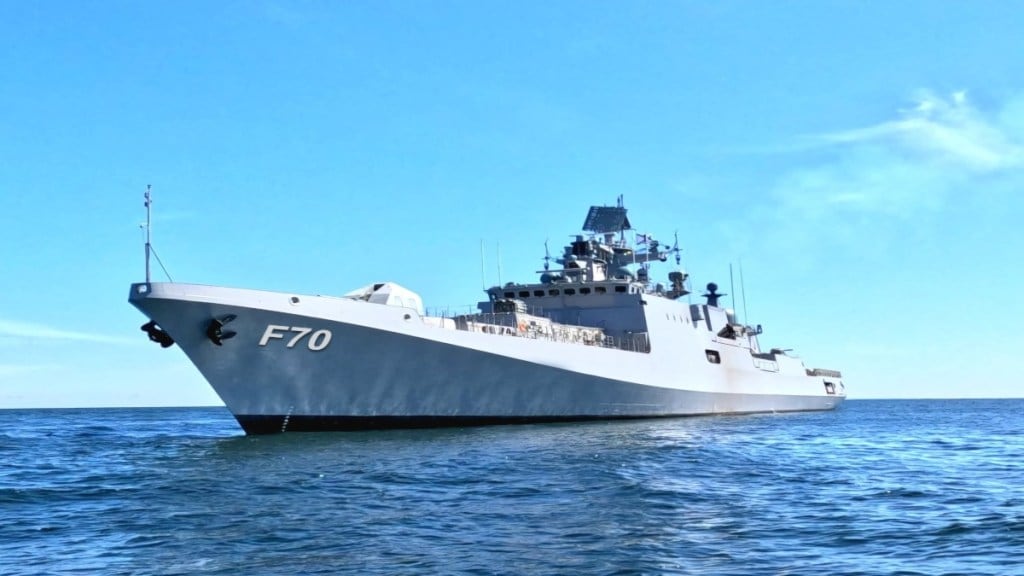The Indian Navy’s newly commissioned stealth frigate, INS Tushil, has recently been deployed to Karwar, located in North Karnataka. This strategic move is poised to significantly enhance India’s maritime security and regional naval presence, especially as Karwar becomes the focal point of India’s ambitious maritime defence initiatives. The INS Tushil’s deployment also underscores the growing naval cooperation between India and various global partners, as well as the critical role that Karwar’s naval base—Asia’s largest—is set to play in India’s broader maritime defence strategy.
The INS Tushil and its Journey
INS Tushil, which was commissioned on December 9, 2024, in Kaliningrad, Russia, represents a key addition to India’s naval capabilities. The frigate, built by Russia, is equipped with advanced stealth technology, making it less detectable by radar, and is designed for multi-role operations, including anti-submarine warfare and air defence. After its commissioning, INS Tushil made its way to its home port at Karwar, with a stopover in Casablanca, Morocco. This journey highlights not just the operational mobility of the ship but also the growing naval diplomacy between India and Morocco, a maritime nation strategically located between the Mediterranean Sea and the Atlantic Ocean.
The visit to Casablanca is part of strengthening bilateral naval cooperation, as India seeks to foster closer ties with Morocco’s Royal Navy. Over the past year, several Indian Navy ships, such as Tabar, Tarkash, and Sumedha, have visited Morocco, promoting interoperability between the two navies. INS Tushil’s interaction with the Royal Moroccan Navy, including a Passage Exercise (PASSEX), further strengthens these ties, while also allowing both navies to share best practices and enhance operational readiness.
Karwar: Asia’s Largest Naval Base
The real significance of INS Tushil’s deployment, however, lies in its final stationing at Karwar, which is fast becoming one of the most vital naval hubs in the Indo-Pacific region. Asia’s largest naval base, located near Goa, is a critical component of Project Seabird, an ongoing initiative to expand and modernize India’s naval infrastructure. Spanning 25 kilometers and capable of hosting more than 50 warships, submarines, and smaller crafts, Karwar will become a major strategic asset for India.
The centerpiece of this project is the construction of a 75-meter high dry-berth, which will be taller than Delhi’s Qutub Minar. This facility will allow for the simultaneous docking and maintenance of multiple warships, including the capability to service up to four ships at once. Such infrastructure is not only essential for maintaining a large fleet but also for ensuring that India’s naval forces can project power and respond swiftly to regional maritime security challenges.
A Hub of Maritime Security and Diplomacy
INS Tushil’s deployment to Karwar represents more than just a strategic military move—it is a key aspect of India’s broader effort to solidify its maritime dominance in the Indo-Pacific. Karwar’s location on the western coast of India gives it easy access to the Arabian Sea, one of the world’s busiest and most strategically important shipping routes. With increasing Chinese naval activity in the Indian Ocean Region (IOR), India’s enhanced presence at Karwar provides a clear message of commitment to regional security.
Project Seabird, which is developing Karwar into a state-of-the-art naval base, includes multiple components such as a naval air station with a 2700-meter-long runway. This air station will support not only naval operations but will also serve as a commercial enclave, adding a civilian dimension to the base. The ongoing development will eventually support a workforce of 50,000 personnel, making Karwar a major economic and military hub.
Naval Diplomacy and Regional Influence
INS Tushil’s journey and eventual stationing at Karwar reflect India’s growing focus on maritime diplomacy. The ship’s visit to Morocco and participation in cooperative naval exercises with regional partners highlight India’s commitment to enhancing its naval cooperation with countries in the Indian Ocean and beyond. These initiatives are part of India’s broader strategy to counterbalance China’s increasing influence in the region and ensure that India maintains its position as a dominant maritime power.
Moreover, India’s engagement with countries like Morocco through naval exercises, port visits, and joint operations helps promote mutual trust, interoperability, and collective maritime security. By strengthening ties with regional and extra-regional powers, India is building a network of maritime partnerships that can collectively address security challenges, such as piracy, maritime terrorism, and the protection of sea lanes.





